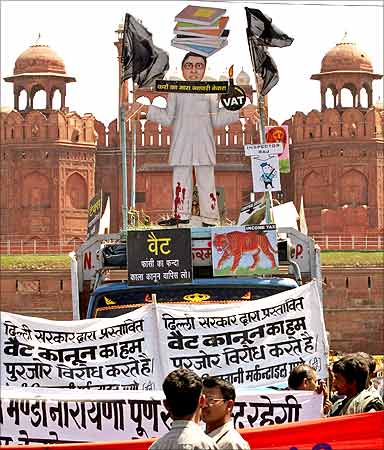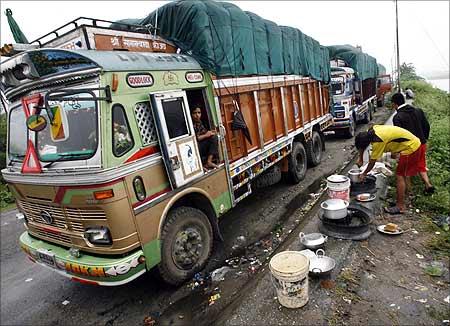 | « Back to article | Print this article |
The interesting story behind how GST evolved
It is India's most radical tax reform. The Goods & Service Tax (GST), expected to be launched next year, will replace around 16 taxes, including central excise and service tax as well as state levies like value-added tax (VAT), stamp duty and entry tax.
It has the potential to increase the country's GDP by $500 billion and exports by up to 15 per cent.
India's hugely complicated tax system, with multiple taxes and overlapping jurisdictions, hurts investors and households alike, contributing to the economy's uncompetitiveness.
Reforming this complex system has been a Herculean task for an army of tax administrators, fiscal experts and state finance ministers.
Raja Jesudoss Chelliah was the father of tax reforms in India. He conceptualised the reform framework and was part of the committee on financial sector reforms, chaired by M Narasimham, whose reports ushered in dramatic changes in the tax system and, subsequently, in Centre-State financial relations. These paved the way for liberalisation.
Hardly anyone in the country has done as much for the cause of public finance research and reform. His contribution to the design and implementation of tax reforms is particularly notable.
Click NEXT to read on . . .
The interesting story behind how GST evolved
In his 1993 report laying a roadmap for reducing import duties, Chelliah suggested a study of central excise duties.
The late Amaresh Bagchi, director, National Institute of Public Finance & Policy, was tasked with this study, including a possible GST.
He initially thought India could develop a dual-GST model like Canada, but changed his view after academics helped him see this would make the Centre too strong.
International experts also pointed out that a GST was too ambitious a reform for India because of a culture of non-compliance, bad tax administration, poor technology and a large unorganised sector.
As a result, many of the concerns being raised today on the financial autonomy of states -- their right and ability to levy taxes -- were first raised by Bagchi.
He felt states needed autonomy and should not be dependent on handouts from the Centre. He ultimately did not suggest a dual-GST for India, but only a reform of state taxes.
Click NEXT to read on . . .
The interesting story behind how GST evolved
Parthasarathi Shome, who was adviser to then finance minister P Chidambaram, had good chemistry with Asim Dasgupta, chairman of the empowered committee of state finance ministers, which implemented VAT and will oversee GST.
They had mutual respect for each other, and understood the technical aspects of VAT. He produced an outstanding white paper on GST in April 2008, which received the endorsement of states, says Satya Poddar, partner, Ernst & Young.
That paper outlined a GST model, which dovetailed neatly with the GST model recommended by a task force constituted by 13th Finance Commission chairman Vijay Kelkar.
Unfortunately, Shome's paper was never made public. He quit in 2008, after being passed over for the post of Union revenue secretary. If he had been selected, he would have been the first fiscal policy expert in that position.
Kelkar's paper was his second recommendation on the introduction of GST. The first was in a report on implementation of the Fiscal Responsibility & Budget Management Act, 2003.
Click NEXT to read on . . .
The interesting story behind how GST evolved
He constituted a task force that used Amaresh Bagchi's paper to prepare a detailed report on how GST could be implemented. "Kelkar felt his job was done and that he didn't have to convince the empowered committee. He focused on producing a detailed white paper and put his weight behind it," says an expert.
The task force was headed by Arvind Modi, an IRS officer from the direct tax group. He used the income-tax database of 34 lakh (3.4 million) corporate tax returns and quantified a revenue-neutral GST rate of 12 per cent (7 per cent for states and 5 per cent for Centre) that would replace taxes like VAT, central sales tax, entry tax, stamp duty, and electricity duty.
When Dasgupta saw those numbers, he was elated. He is believed to have said that if the numbers were valid, he would go to the prime minister and announce introduction of GST.
This was a week before Manmohan Singh had heart surgery and for some reason the meeting never took place. States felt the rates were too low and asked National Institute of Public Finance & Policy Director Govind Rao to validate them. He came up with estimates that were double or triple the proposed rate.
Dasgupta may have failed to lift West Bengal's finances, but when it comes to forging a consensus, the nation keeps turning to West Bengal's finance minister.
Click NEXT to read on . . .
The interesting story behind how GST evolved
As the head of the empowered committee, Dasgupta's job is to forge 35 states and Union into a consistent viewpoint, irrespective of their political considerations.
The Centre was so happy with the implementation of VAT, that Chidambaram lost no time in announcing a GST, and requested the same committee that had implemented VAT to oversee GST.
Dasgupta has covered significant ground on GST thanks to his stature and a voice that is heard and acknowledged. He also enjoys a good equation with Finance Minister Pranab Mukherjee; they have known each other since the 1970s.
The team of central government officials closely associated with the GST is headed by revenue secretary Sunil Mitra, supported by key officials from revenue headquarters and Central Board of Excise & Customs (CBEC).
Those from revenue headquarters include additional secretary Jose Cyriac, joint secretary A K Srivastava, and director Shikhar Agarwal. They are working on how state taxes like stamp duty can be subsumed by GST.
Click NEXT to read on . . .
The interesting story behind how GST evolved
This group is supported by six key officials at CBEC, including chairman V Shridhar, member (Central Excise) S Datt Majumdar, member (computerisation) Y G Parande, joint secretaries at CBEC's tax research unit, Vivek Johri and Gautam Bhattacharya, and Excise Commissioner Ajay Jain.
It has also set up a team under retired D G Gautam Ray to draft the procedures and legislation in tandem with VAT commissioners.
Three or four state commissioners are among the more active and head sub-working groups of the empowered committee.
These include Sanjay Bhatia (Maharashtra), Y P Gupta (Gujarat), H K Dwivedi (West Bengal) and Rajiv Ranjan (Tamil Nadu). Bhatia, for instance, heads the sub-committee on taxation of services. Many of the other commissioners are members of two other sub-groups, which include Johri and Bhattacharya.
Opposition from states was led by Madhya Pradesh and its finance minister, Raghavji. But many believe the man behind Raghavji is A P Shrivastava, principal secretary, commercial taxes, Madhya Pradesh.
Click NEXT to read on . . .
The interesting story behind how GST evolved
In May 2009, when the Kelkar report was given to states, Shrivastava began talking with Sumit Bose, an Indian Revenue Service officer from the MP cadre, who was then the secretary, 13th Finance Commission.
"Shrivastava became active and formed a view that GST is a bad tax. He has had a significant impact on Raghavji in opposing GST," says an observer.
They kept asking what the benefit of GST would be for states. When the constitutional amendment Bill was tabled, MP said it would undermine the states' fiscal autonomy.
Starting with Madhya Pradesh, all the states ruled by the Bharatiya Janata Party have joined the opposition: Gujarat, Chhattisgarh and Karnataka. They are led by Gujarat FM Saurabh Patel and Raghavji. They say GST is discriminatory, anti-poor and that producing states will be losers.
"The opposition is more political than anything else, at least in Gujarat. Chhattisgarh and Madhya Pradesh may have genuine concerns," says Pratik Jain, partner & executive director at audit and tax firm KPMG.







